It was almost by accident that I visited the Mohammadpur Geneva camp in Dhaka – one of the largest settlements housing thousands of stranded Pakistanis in Bangladesh. On my last visit to Dhaka, my guide Ronny offered the possibility of getting the best bihari kebabs in town. He told me that his house was near the place and I could meet him somewhere close.
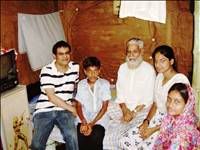
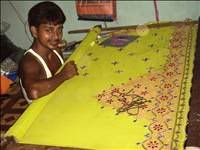
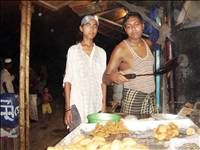
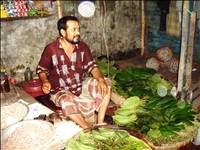
This was an extraordinary afternoon when the receding sun was converting the sky into a field of unimaginable colours that artists can only aspire to create through their limited palettes. Dhaka, the noisy, overcrowded megapolis can be enchanting at times, especially during late springtime when the Krishnochura trees (the Flame of the Forest) bloom all over with their fiery flowers.
I almost cancelled the trip thinking that a walk in the park might be a better alternative to the usual South Asian gluttony. Quite soon, I arrived at the meeting point having rationalised my proclivity for indulgence.
Little did I know that the meeting point was nowhere but at the doorstep of Dhaka’s underbelly, the easy to ignore Bihari camp. Not until I had reached there had I realised how the wounds of 1971 were festering for hundreds and thousands of men, women and children who have waited for all these years to attain identity and citizenship of Pakistan. As if it were a curse, the Pakistani state soon forgot about their existence as its ethnic politics dominated the policy commitments of Bhutto. And for the Bangladeshis these were the “traitors” who continued to wave Pakistani flags when the vast majority of East Pakistanis revolted against the excesses and the might of Pakistan army following the infamous and mischievous army action of 1971.
In a few minutes I had all but forgotten about the famous Mustaqeem kebabs and parathas and forced Ronny to take me inside the camp. Very soon I realised I did not need any Bangla-speaking guide as the ghetto was Urdu speaking, and portraits of Pakistani leaders and flags could still be spotted despite the passage of three and a half decades. Ronny knew the locals and found his younger friends, child workers and idle youth who took charge of our little tour.
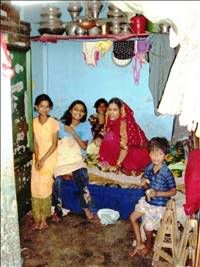 Shamed by guilt and excited by the real experience, I wandered the smelly, open-drained and dark streets of the ghetto. I have frequented other slums but this one was special for it reeked of the contemporary elite politics, bloodshed and cold inhumanity that Pakistanis are shy of confronting. The living conditions would put any half-concerned South Asian to shame. The homes for most of the families comprised tiny little rooms, with all the belongings and large families concentrated in the inner space. No proper toilets and water supply – as if civilization had taken a backseat here.
Shamed by guilt and excited by the real experience, I wandered the smelly, open-drained and dark streets of the ghetto. I have frequented other slums but this one was special for it reeked of the contemporary elite politics, bloodshed and cold inhumanity that Pakistanis are shy of confronting. The living conditions would put any half-concerned South Asian to shame. The homes for most of the families comprised tiny little rooms, with all the belongings and large families concentrated in the inner space. No proper toilets and water supply – as if civilization had taken a backseat here.
The tragedy of these stateless people was immense and of an in-your-face variety. Such moments can only be experienced – readings and theorisations rarely help. Mohammadpur is just one of the 116 camps all over Bangladesh set up immediately after the Liberation War of 1971, euphemistically referred to as the “Fall of Dhaka” in our textbooks. How did all this happen?
Not unlike much of the mess afflicting the region, the Partition of India in 1947 witnessed large-scale communal riots and thousands of Muslims from Bihar, West Bengal and other provinces arrived in what was known then as East Pakistan. The refugee settlements, reminiscent of Karachi, were inward looking monocultural spaces, a little away from the Bengalis. In the complex political economy of a united Pakistan, “Biharis,” by now a composite term for the non-Bengali Pakistanis in East Pakistan, became the object of Bengali ire based on common perceptions that the state gave them a preferential treatment. It is estimated that by 1971, over 1.5 million such non-Bengalis, ‘Biharis,’ were present in East Pakistan.
In 1971, the Biharis were a torn community. The Pakistan army, sensing this divide, apparently recruited some Biharis to fight the rebellious Bengalis. Whether they supported the Pakistan army or not, many Biharis remained neutral in 1971, shy of taking sides with their local brethren.
Thus the schism widened in those tumultuous years leading to the sub-human ghettoisation of the wretched children of a lesser God. After the war in 1971, the International Community for the Red Cross intervened and found out that most Biharis wanted to migrate to the truncated Pakistan. Over half a million registered “Urdu-speaking” Pakistanis found a voice at the high level Simla pact of July 1972 and later an agreement was reached in 1973 between Pakistan, India and Bangladesh on this issue. As per the agreement, the Bengali prisoners were released and sent to Bangladesh. However, not all Urdu-speaking Pakistanis were repatriated to Pakistan. Even today hundreds of thousands live in Bangladesh in camps as non-citizens.
So Mohammadpur turned out to be an encircled little inferno located next to fairly well-to-do neighbourhoods and commercial areas. Human spirit however knows how to counter the forces of nature and history. Inside the camp, little Bihars had been recreated with the memories and longings that the migrants are well known for. The cuisine, the sweets and eateries were all preparing and selling the Bihar delights: Pua, prepared from a mixture of powdered rice, milk, ghee, and honey, Pittha (steamed powdered rice mix), Khaja (a sweet delicacy); and Ladoos, Kala Jamun, and so many others that have escaped my memory.
Handicrafts and automobile repairs were common professions. As I peeped into the dingy rooms – homes and workshops rolled into one – women and men were busy working on brightly coloured saris. Many youth find this their ordained profession. There were also places for recreation: snooker, carom boards and tea stalls. We stopped at a tea stall and sipped the milky tea with lots of sugar served with anarasas (sweet round-shaped snacks). For some reason many people had gathered there and my Pakistani status was now well-known. Details of Pakistan, Karachi and lost relatives were recounted with much passion. The tea stall owner, Ahmad’s brother, had escaped to Pakistan but Ahmad never heard from him for years. Sometimes these situations land you in a zone where words are empty and meaningless; and perhaps listening becomes the best mode of communication.
We got up and reached another side of the slum packed with Urdu-wallahs. There is obviously a hint of racism when the Biharis are mentioned in the mainstream parlance in Bangladesh. The older generation complains more than the younger ones, who by their situation are better integrated and bilingual. At a carom club, the young men tell me they like Pakistan but do not wish to go there. “This is our country and our home, we are Bangladeshis.” Others nodded and chuckled at the remark. Free of the baggage, the younger generations are far more ready to become Bangladeshis.
Probably this is the reason that civic activism has earned voting rights for those born after 1971. The court ruled in 2008 that “the refugees who were minors in 1971 or born after the independence of Bangladesh are citizens of Bangladesh,” after years of legal wrangling and ideological debates in the country. However, those who were adults in 1971 were not covered.
The warmth for a Pakistani was more palpable among the elderly. I was treated with much affection in their houses. Yes, I did visit them as well, trying hard to disguise my shock at what constituted “housing.” But the conversations were fun-filled and hearty. Mirza Saheb from Muzaffarnagar related the stories of how he migrated as a child with his family after communal riots of 1947 nearly destroyed them. Respect for Jinnah and the idea of Pakistan also filtered through the discussions. But then there were witty lines and little anecdotes as well on how some Pakistanis were half or quarter Pakistanis. The full status could only be earned if you are not a Bihari!
Education is a casualty. In part this is a result of marginalisation from the state services and in most cases a simple case of poverty where family-based work for money is more important than the luxuries of schooling. Stories of discrimination were also related as to how difficult it was get a job when you were from a stateless camp.
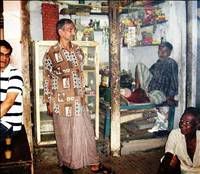 Arif, a rickshaw-puller, narrated the woes of getting registered as a rickshaw-wallah without an identity card. He had bribed his way through and somehow used the black economy to remain employed. His wife, Nazia, a cheerful and attractive woman, insisted that I should have tea. I stayed longer. The family watched a lot of TV, especially the Indian soaps as they were in Hindi/Urdu and thus accessible. In fact, most homes had TV sets fixed on the walls – the fruits of globalisation quite evident and pluck-able.
Arif, a rickshaw-puller, narrated the woes of getting registered as a rickshaw-wallah without an identity card. He had bribed his way through and somehow used the black economy to remain employed. His wife, Nazia, a cheerful and attractive woman, insisted that I should have tea. I stayed longer. The family watched a lot of TV, especially the Indian soaps as they were in Hindi/Urdu and thus accessible. In fact, most homes had TV sets fixed on the walls – the fruits of globalisation quite evident and pluck-able.
I was concerned about Ronny, my companion, who stayed with me throughout. He later confessed that he did not approve of such treatment of the Biharis and in fact many people of his generation were appalled at this. Ronny also made his fondness for the Pakistani cricket team and beautiful girls quite clear, relating how he had a little internet romance with a girl in Karachi. But she was married before he could muster the finances and courage to actually visit Pakistan. Now he was married to another Bangladeshi-Kuwaiti girl whom he also met on the internet after the stymied Pakistan love-chapter.
Ronny’s banter lightened my inner turmoil. Another dose of escapism was offered by the tender and delicious kebabs that we devoured at the end of the camp visit. And I can say for sure that these were the best Bihari kebabs I had tasted. As we finished our late dinner, I noted how a newly constructed glitzy apartment tower overlooked us and the Geneva camp.
There is a Stranded Pakistanis General Repatriation Committee, the courts have issued rulings and the politicians in Pakistan religiously issue statements each year bemoaning the plight of the stranded Pakistanis. True, many Biharis would not return but those who want to might just die dreaming of a homeland that never will be. In South Asia we have made a royal mess of things – first the Partiton, the violence against Bangaldeshis and our refusal to admit that we were wrong; and then such insensitivity to those who are trapped between conflicting histories and ideologies.
Raza Rumi is a writer. He blogs at www.razarumi.com and edits a cyber magazine, Pak Tea House, and the Lahore Nama blog-zine.




















































Good to see that my article has generated a discussion. However, I wonder why the comments here get derailed – completely away from the topic.
This is a post about the stranded Biharis and NOT the refugees from Bajaur. And, similarly, this is not an article about slavery to the US or Zardari.
It is amazing that Pakistanis – at home [and here mostly] abroad just cannot focus on issues – and the 24 comments above reflect what ‘Pakistaniat’ can be all about!
Owais and Adil – thanks for publishing this.
cheers, Raza
I am very grateful to Adil Najam for bringing up this topic. These unfortunate victims of the Army’s “operation” in East Pakistan are better Pakistanis than the Nawabzadas, Makhdoomzadas, Khanzadas or Haraamzadas who rule and plunder Pakistan’s bureaucracy, military, politics and judiciary. They have sacrificed for Pakistan and have stood by saluting Pakistan’s national flag and anthem every single day of their lives since 1971. They get abused and blamed for the excesses of the Punjabi army by the Bangladeshis in which they certainly had no part.
The 1971 debacle is seen at different levels of maturity by different Pakistanis. As I see it, it was deliberate secession by feudal Pakistan (West Pakistan) achieved with premeditated crimes-against-humanity against the non-feudal East Pakistan. The shameful crimes that one group of Muslims committed against other Muslims were unheard of, even in the Hindu-Muslim riots of 1947.
How West Pakistan managed to alienate and subjugate East Pakistan which had hosted in 1916 the All India Muslim League’s Dhaka historical meeting requires a depth of Pakistan studies which is beyond the grasp ordinary Pakistanis. Not only was the Hamoodur Rahman Comission report concealed since 1971 by the Army until Pervez Musharraf published it, but the perpetrators of the crimes were never brought to justice.
Zulfiqar Bhutto who was used by the feudal forces to abuse friendly Christian countries in the UN which were trying to save Pakistan was made Prime Minister before he was hanged. Yahya Khan was allowed to retire in disgrace but never questioned about his incompetence and treason. Tikka Khan was made governor of Punjab.Tikka Khan was made governor of Punjab. General Niazi who surrendered before an Indian general in Paltan Maidan Dhaka remained in denial until his end-of-days about his actions. None of the other Army officers named and shamed by the Bangladesh government were ever brought to book. The PPP old guard which was the political entity behind the destruction of Pakistan was never asked about “idhar tum…udhar hum” slogan. When the Indian embassy in Saudi Arabia celebrated its victory in 1971 a Muslim employee of the embassy was shocked to see that Pakistanis were the foremost in distributing “mithai” about Pakistan’s humiliation. What more evidence does one want of the “patriotism” of Pakistanis?
Perhaps greater evidence is the ignorance that the feudal establishment has instilled into Pakistan’s collective sub-conscious about 1971. Otherwise the atrocious occupation of Karachi from 1992-99 by Mian Nawaz and cronies would never have happened.
As a Karachiite I am proud to say that Major General Yaqub Khan , who later became Pakistan’s foreign minister resisted feudal attempts to be set up as the commanding officer of Yahya Khan’s massacres in East Pakistan…
Nihari: in the pre-partition India Muslims never lived in ghettos and actually the only ghettoized class was the untouchables…
Sub-classification is a post-partition phenomenon mainly due to a large scale migration of Muslims from India in the new regions where they never mixed up with the locals.
Declaration of Urdu as a national language also played a significant role in this mentality – you see, the hosts were not only to accommodate the newcomers, they were to speak their language as well – and hence the polarization. Hindsight is 20/20 and if there were enough educated Muslims, and statesmen, the outcomes may have been very different. This deficiency plagues Pakistan even now.
Nevertheless, returning to the subject of the ATP post, the problem of people stranded in BD needs humanitarian solution!
@Naseem,
hope the tough ride doesn’t end up in a war in this region!
because, 1930s depression really ended with WWII…
and my mind is making a moronic comparison to the current state over the horizon of next 5-6 years!!
@an indian,
Jinnah was a muslim with a distinct British bias to him. He refused to believe that peoples would behave differently than him. secularity was more important security…alas our founder was found wanting…and he died too early to make a difference with any ideas he might have had.
The hawks after him with the “normal” bias have been showing us how wrong he was….
Hold tight…we are in for a tough ride